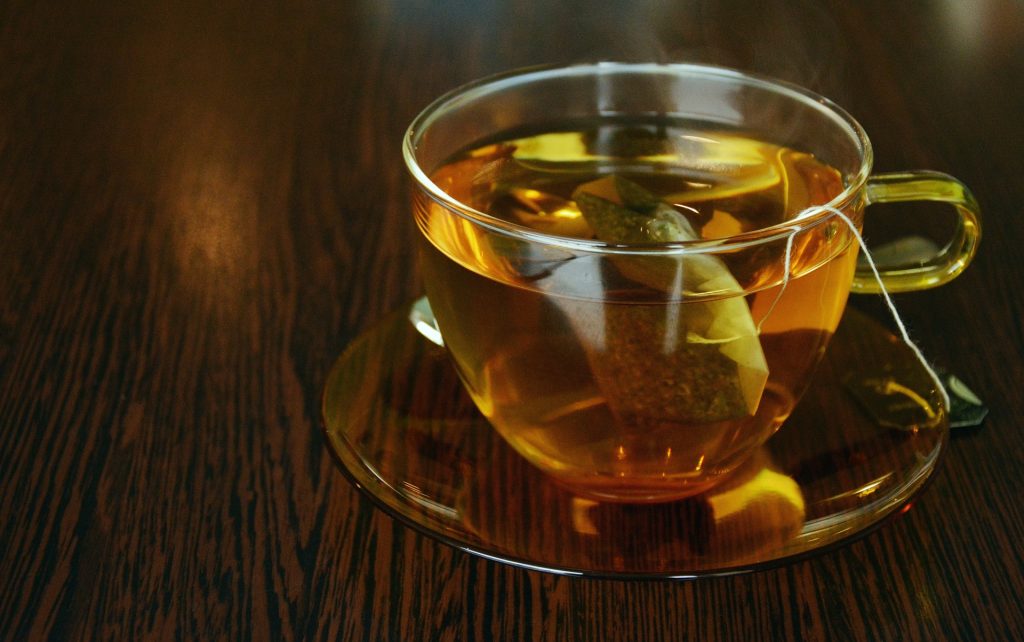 Fluoride is a trace mineral in human nutrition. There is some evidence that fluoride may be essential, although this point of view is controversial. For example. Fluoride is said to be required for the hardening of tooth enamel and the prevention of dental caries, but the case for this is not clear. While there is some evidence that fluoride can protect from dental caries, it is not clear whether the ingested and absorbed fluoride is able to reach the tooth enamel. It might be that fluoride protects the tooth enamel through topical application for example. Tea is a rich source of fluoride, and studies have shown that the fluoride from tea binds to tooth enamel tightly upon drinking tea. This may suggest that food borne fluoride is indeed bioavailable to teeth and might be one way that fluoride protects from dental caries. However, fluoride is a potent antimicrobial agent, and as such the fluoride in tea might be protecting the teeth not by hardening the enamel, but simply by killing the bacteria that cause dental caries.
Fluoride is a trace mineral in human nutrition. There is some evidence that fluoride may be essential, although this point of view is controversial. For example. Fluoride is said to be required for the hardening of tooth enamel and the prevention of dental caries, but the case for this is not clear. While there is some evidence that fluoride can protect from dental caries, it is not clear whether the ingested and absorbed fluoride is able to reach the tooth enamel. It might be that fluoride protects the tooth enamel through topical application for example. Tea is a rich source of fluoride, and studies have shown that the fluoride from tea binds to tooth enamel tightly upon drinking tea. This may suggest that food borne fluoride is indeed bioavailable to teeth and might be one way that fluoride protects from dental caries. However, fluoride is a potent antimicrobial agent, and as such the fluoride in tea might be protecting the teeth not by hardening the enamel, but simply by killing the bacteria that cause dental caries.
Fluoride is highly poisonous above a particular threshold. High intakes of fluoride can cause a condition called fluorosis, which can lead to serious bone and joint deformity and pain. Fluoride is also a neurotoxin and may have irreversible effects on mental health if levels remain elevated, particularly during development. Blood levels of fluoride are typically around 1 to 3 μmol/L, and blood levels peak at around 1 hour following ingestion. After about 3 to 6 hours, fluoride level return to their baseline levels. Most fluoride in humans (99 %) is bound to calcified tissues. However, this binding is not irreversible as the calcified tissue acts as a reservoir of fluoride and can release and bind the fluoride in a bidirectional manner. Fluoride also passess into the soft tissue forming a labile pool. Fluoride concentrations in sweat reflect the concentration in the blood, and elimination is sweat may therefore be limited to 0.02 to 0.06 mg of fluoride per litre of sweat. Most fluoride is likely excreted in the urine or faeces.

Tea is a rich source of fluoride as the tea plant (Camellia sinensis) bioaccumulates fluoride. The fluoride content of economy (cheaper) black tea may be higher than the fluoride content of more expensive black tea and green tea because more expensive tea and green tea tends to use younger tea leaves containing less fluoride. Younger leaves contain less fluoride because they have not had time to accumulate the same amount as fluoride as older leaves. As white tea uses the freshest newest leaves from the tea plant, the fluoride content of white tea may be the lowest. Brick tea is a form of black tea consumed in parts of Asia, particularly China, which is made from the oldest tea leaves. Brick tea is particularly high in fluoride. Based on a 1.5 L ingestion of tea per day from black tea, 56 % of black tea tested in one study would provide too much fluoride to stay within the safe range. In the same study, 24 % of the black tea tested would cause an increased risk of osteofluorosis and fractures.
Fluoride is an air pollutant and hydrogen fluoride ingestion can occur through the lungs. However, for most individuals, dietary fluoride is the major source of fluoride. Freshwater levels of fluoride are around 0.1 ppm to 100 ppm depending on the source of the water. In some geographical areas fluoride is added to the water under the guise of aiding dental health, however this is controversial. Freshly prepared foods can contain from 0.01 to 1.0 ppm fluoride. A major exception to this is fish and tea. Oceans have a fluoride concentration of about 1.5 ppm fluoride and so fish accumulate fluoride. Mackerel for example may have a fluoride concentration of between 6 and 27 ppm. The tea plant Camellia sinensis bioaccumulates fluoride from the soil and dried tea leaves can contain between 4 and 400 ppm fluoride. Those regularly consuming fish and tea, such as the Japanese, may therefore have high intakes of fluoride naturally in their diets. However, there is no evidence that this is a cause of health problems.

Accidental ingestion of toothpaste may be a significant source of fluoride ingestion. Up to 25 % of toothpaste may be accidentally swallowed by some individuals during brushing. Toothpaste labels carry a warning about seeking medical advice if accidental swallowing of toothpaste does occur.
Ingesting fluoride through the consumption of tea is of interest nutritionally, because tea is a rich source of fluoride. This may suggest that consumption of tea is detrimental to the health. However, studies show that those who consume tea regularly are protected from many diseases including those of neurodegeneration. As fluoride is a neurotoxin, this may suggest that the fluoride in tea is not problematic to the health of the consumer. Studies show that the fluoride content of cheap economy tea leaves are the highest, with the fluoride content ranging from 3.60 to 7.96 mg/L. The dietary reference intake (DRI) for adults in the United Kingdom in 4 mg per day for adults. Consuming 1 litre of the economy tea made with a fluoride content of 6.0 mg/L would provide between 2 and 4.8 mg of fluoride if consumed with food and around 6 mg of fluoride if consumed when fasting, possibly exceeding the DRI for fluoride ingestion. However, it is unclear what effects this level of consumption might have from tea over the long term.

Tea contains calcium fluoride. The form of fluoride added to toothpaste is sodium fluoride. Calcium fluoride is less soluble than sodium fluoride and so the absorption may be lower. In addition, coadministration of calcium with fluoride may significantly reduce the absorption of the fluoride. Consuming 1.3 grams of calcium carbonate decrease fluoride blood levels by 22 %. Drinking milk with tea may therefore be expected to reduce fluoride absorption from the tea because of the calcium in the milk. However the type of calcium coadministered may be important. Carbonate is an alkaline salt, and this may be required in order to inhibit fluoride absorption. Other forms of calcium may be less effective.
One substantial source of fluoride may be the accidental ingestion of fluoride from toothpaste. A case study published in the literature reported on a woman who had developed fluorosis from over consuming fluoride. Upon questioning it became apparent that she consumed around 6 cups of tea daily and had dome for 5 to 10 years. The total ingestion of fluoride from tea was estimated to be 7.6 mg/L which provided 10.9 mg of fluoride per day. The researchers estimated that fluoride concentration of the tap water was low at 0.3 ppm. However, the woman also revealed that she cleaned her teeth 8 to 10 times a day due to a phobia of dental caries, consuming one tube of toothpaste each week. As around 25 % of toothpaste used for brushing can be ingested accidently, the researchers estimated that this excessive brushing may have provided 4.2 mg of fluoride. Tea and toothpaste therefore provided 15.1 mg of fluoride, with another 2 to 3 mg coming from other dietary sources.
Eat Well, Stay Healthy, Protect Yourself
RdB
